Your Event Marketing Handbook: 12 Strategies to Get More Attendees
Astley Cervania
Content Contributor, HeySummit
All event organizers have an end goal – making a profit and generating leads.
Getting attendees to your event is one thing. Nurturing them to become paying customers is another. But both outcomes have one thing in common: effective event marketing strategies.
In this ultimate guide, you’ll learn everything you need to know about event marketing to generate traffic, leads, and revenue. We’ve also included actionable steps so you can start implementing the things we discuss right away.
What Is Event Marketing?
Event marketing involves promoting a brand, product, or service by delivering a memorable experience for attendees. This is also sometimes referred to as experiential marketing since the bottom line of a successful event is one that delivers an exceptional brand experience.
The goal of each event is to create an engaging experience that leaves a lasting impression on attendees. These events come in different forms such as trade shows and online conferences.
There are steps to take before, after, and during an event. Here’s an example:
Pre-event: setting up the landing pages and posting on social media.
During the event: Posting Twitter threads, event hashtags, and live streaming on YouTube.
Post-event: analyzing attendee engagement metrics and sending automated email follow-ups.
It’s crucial to understand your target audience’s needs so you know what type of event would resonate most with them. Anyhow, we’ll get into the event marketing process from start to finish later on in this guide.
Why Event Marketing is Valuable for Businesses
Events are memorable. A well-executed event builds brand awareness and credibility, which generates leads and increases sales through word of mouth. It’s also a great way to connect with your audience on a personal level.
Higher sales revenue. More people become aware of what you’re offering and are more likely to make a purchase during your event where you’ve built up a buying atmosphere.
Valuable data. Get insight into your audience through attendee feedback and by analyzing event performance metrics.
Cement credibility. Well-prepared events build your social proof and reputation in the industry.
Build relationships. Events allow you to nurture your relationship with attendees by connecting with them directly as well as creating opportunities for collaboration with other businesses.
New audience. Reach a new audience of people who may not have heard of you before.
Overall, event marketing can be a core driving force for business growth.
The Main Types of Event Marketing That Generates Leads
There are many different types of in-person and online events that event marketers promote. But, we’ll go through the main ones used as a core strategy for generating leads and traffic. Each of these can be hosted as an in-person, hybrid, or virtual event.
Talk Series
Talk series are a case of inviting someone in your field to discuss their niche.
Sharing relatable or insightful talks is something people would find interesting and valuable. In terms of growing a business, this allows you to extend your reach by tapping into the speakers’ audience.
These episodes can be held on any schedule as long as it’s aligned with your audience’s preferences whether that’s:
Monthly
Bi-weekly
Weekly
Or even daily
Even if you’re early in the awareness building process and not attracting hundreds of committed viewers, you’re still building a stronger connection with your audience by directly interacting with them.
Virtual Summits
Virtual summits are events led by business leaders and industry experts. These are held over a few days or usually every quarter. Or in some cases, they’re hosted every 6 months or once a year.
Summits are effective for scaling your reach and making the most out of all the work you’ve done so far in business. However, launching one at full scale within 1 year might seem a bit far-fetched… but in reality, it’s not.
We’ve seen events being run and organized effectively by small teams and even by just one person. That’s because of using a virtual summit platform like HeySummit, which was designed to make it easy for content creators to put on engaging large conferences and interactive series of talks.
Conferences
A conference is an organized gathering of people who share a common interest. The purpose of conferences is for attendees and keynote speakers to share ideas and knowledge on a particular subject.
Here’s what’s usually involved in a conference:
Talk sessions
Keynote speeches
Panel discussions
Workshops
Networking opportunities
Trade Shows
A trade show is where a company can showcase their latest products or services. In Europe, however, this is referred to as a trade fair.
Trade shows are where companies present their offer to potential customers. It’s also hosted to connect with other businesses and professionals in the industry. Although the general public is welcome to attend, this type of event is tailored for a particular audience.
Businesses host trade shows in large exhibition halls and conference centers. This can last anywhere from a few hours to a few days. Visitors can explore booths and exhibits, attend presentations and seminars, and connect with other attendees. However, this can also take place online assuming you’re using a virtual event platform.
Q&As
Q&A stands for questions and answers. This is an interactive session where viewers get to ask questions to speakers which they’ll answer live. Some of these questions can be asked pre-event, e.g. by using the “ask a question” feature on Instagram stories. Or, these questions can be asked and answered on livestream through the chatbox.
Q&As are great for building awareness and a stronger relationship with your audience. It’s also great as a content strategy because you can gain new content ideas based on the types of questions your viewers are asking.
If you find that your viewers are loving that comment section or live chat, it’s worth considering introducing a Q&A element into your event marketing mix. This can be added to your talk series or even a separate episode depending on what your audience wants.
Product Launch
Product launch events are held for the sole purpose of introducing a new product and creating excitement for potential buyers.
A product launch event often includes:
Product demonstrations
Speeches
Media coverage
Presentations
Afterparties
Testimonials
However, this isn’t the same as a trade show because trade shows are targeted at a wider audience. Plus, trade shows don’t center around a single product launch but rather around the industry as a whole.
Networking
Networking events are where speakers and attendees alike connect with one another. The purpose here is to strengthen professional relationships and open doors for doing future business.
No matter what type of event you choose to run, it’s worth adding opportunities for attendees to connect with one another. In fact, a survey revealed that 55% of respondents wanted event organizers to provide meetups and networking opportunities during their events, according to Statista.
Active participation and interaction are key to a successful networking session. When executed well, both virtual and in-person networking is one of the best ways to build or foster a community.
Webinars/Seminars
Webinars and seminars are about educating or informing attendees on a specific topic. It involves a handful of participants who collaborate, share knowledge, and have open discussions.
The purpose of webinars and seminars is to give valuable information to the audience. Both types of events require audience engagement and interaction.
But the main differences between a webinar and a seminar are that:
Webinars are delivered as online events whereas seminars are delivered as in-person events
The goal of hosting webinars for businesses is often to generate and nurture leads whereas the goal of hosting seminars is to purely educate
12 Event Marketing Strategies for Content Creators and Companies of all Sizes
We’ll go through 12 event marketing examples and strategies that you can use to promote your event.
Note: if you’d like to set up some of these strategies while you’re going through this guide as shown in a few screenshots, you can sign up here to get started for free with HeySummit. We’ve made it as easy as possible to create and organize your event by simplifying the entire process to a step-by-step formula!
1. Landing Pages
Landing pages are website pages that are designed to convert visitors into leads. A well-designed and well-written landing page enables you to boost event registrations and ticket sales. They’re especially crucial for promoting a public online event.
It unlocks a direct line of communication with your target audience by allowing them to sign up using their email. Plus, it unlocks the door to pre-event registrations.
Most importantly, it’s an opportunity to create a positive attendee experience from the very beginning and set a great first impression.
Setting up a landing page is easy with a platform like HeySummit. That’s because it requires no coding skills as they use a drag-and-drop model.
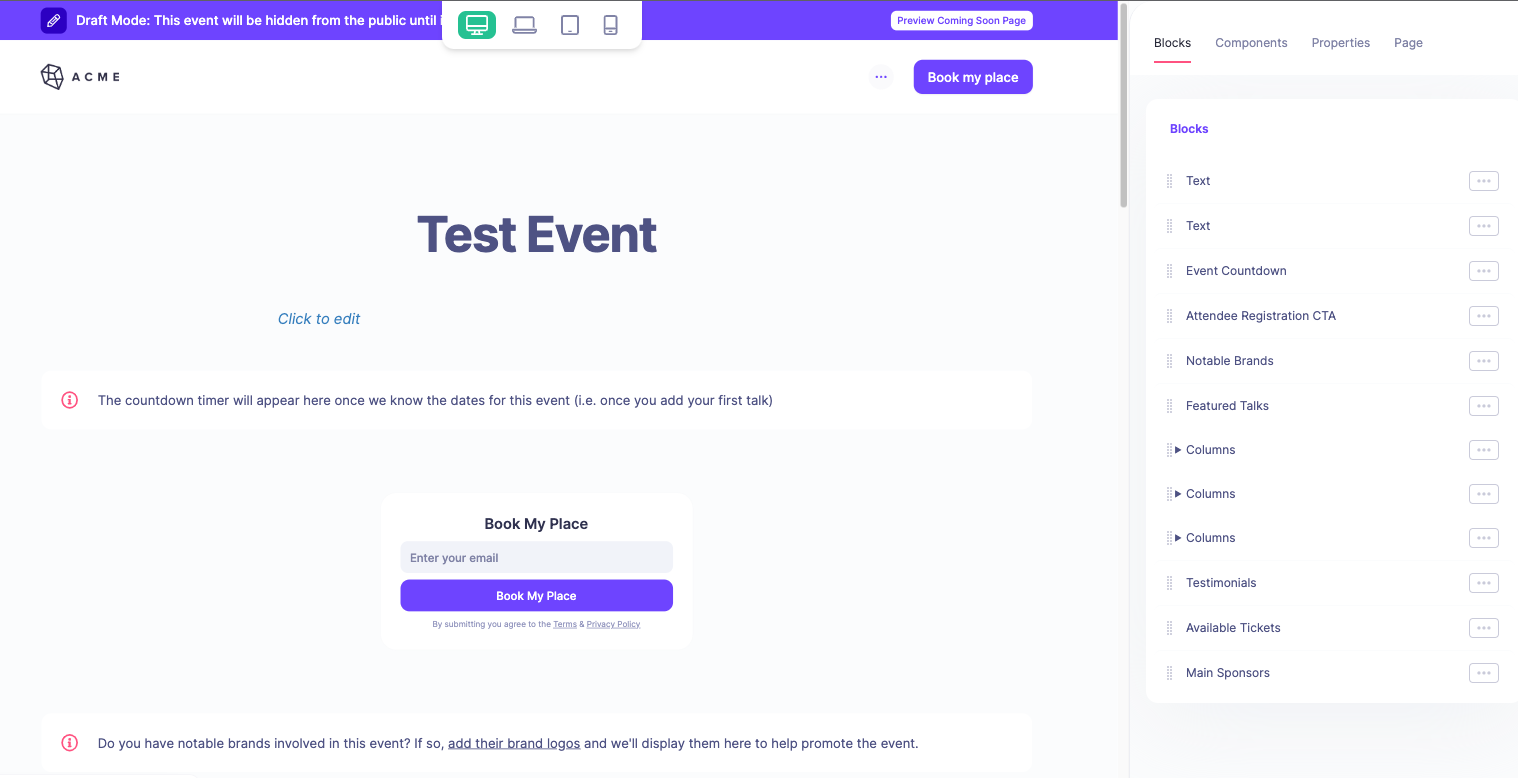
Landing Page Example for Promoting an Event
A common way for solopreneurs and content creators to make money is to set up an online event where attendees can learn from you directly. For instance, let’s say you’re like Daniel – you’ve amassed a number of followers by teaching people how to improve their storytelling skills and how to write better.
Though you’ve built up a community, you’ve yet to make money and generate ticket sales. So, a landing page like this one built from HeySummit would be essential for driving traffic to your event.
2. Email Marketing
Emails are useful because it’s a way for businesses to reach and communicate with attendees on a personal level. Whether it’s pre-event or post-event, email is powerful for keeping your audience engaged throughout the event attendee journey.
Sending personalized emails at the right time nurtures your list of leads and helps you build trust. As a result, this can lead to more sales pre-event and post-event.
Email Marketing Example for Promoting an Event
Use email marketing software like ConvertKit. Or, you can organize your event including email marketing within one place by using a platform like HeySummit.
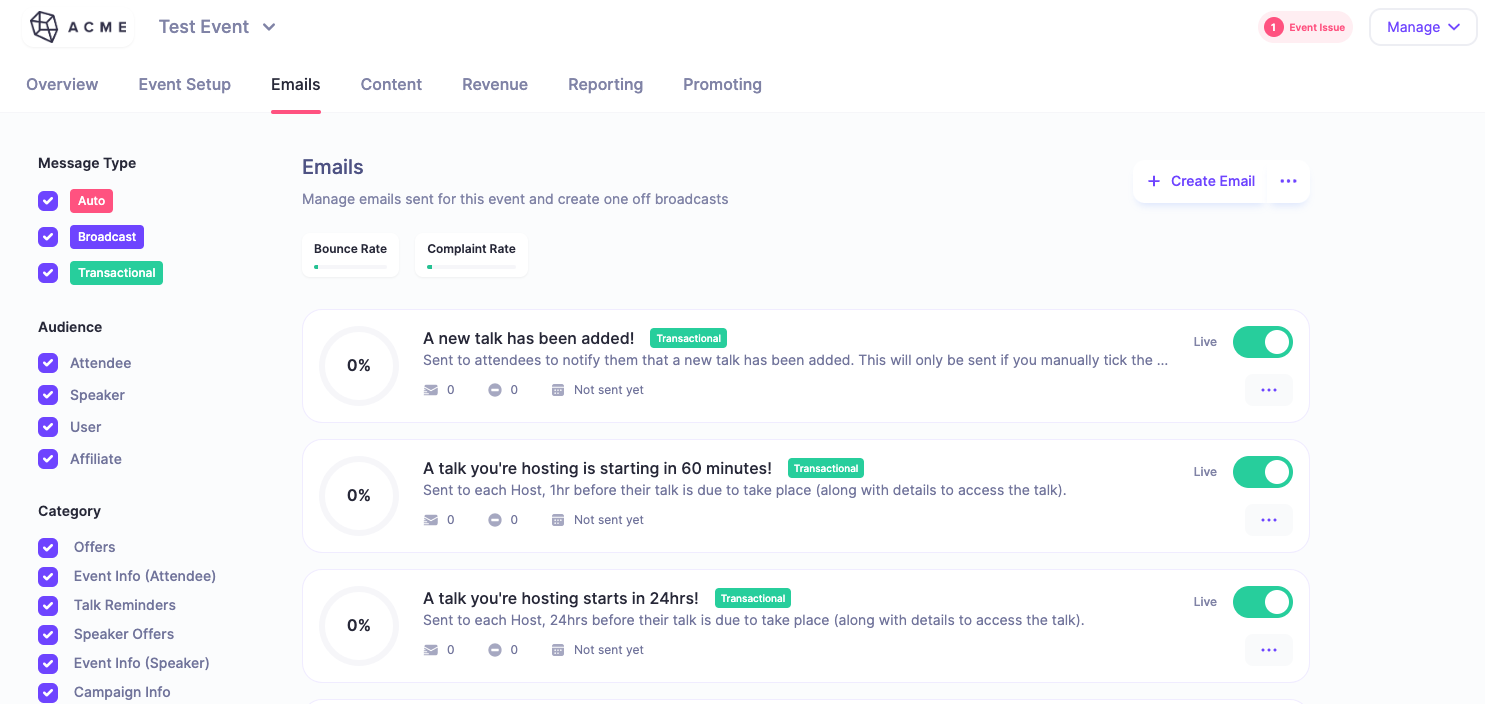
Additionally, here’s an example email that we’ve used for our “Teach Me How to Summit” event.
Subject line: An upcoming event you might be interested in
Dear [Recipient],
Ben here from HeySummit with a quick email on an upcoming virtual event you might be interested in.
The event is called Teach Me How To Summit and as you might have guessed, it's completely focused on helping online business owners learn how to run successful virtual summits - a subject matter that is obviously very close to our hearts.
The event is hosted by a fantastic customer of ours, but we're also sponsoring it because of our shared mission to help people create and deliver incredible events.
All the best,
Ben
3. Affiliate Marketing
Affiliate marketing is where you work with other people to promote your event. These people are known as affiliates, who could be individual content creators or representatives of a large company.
The biggest advantage of affiliate marketing is that it’s a performance-based strategy. This means that you only reward or pay the affiliate after they deliver results, i.e. bringing in new event attendees or customers because of their own marketing efforts.
Here’s some steps to take to get affiliates for your next event:
Identify the right fit: look for businesses and content creators that have a relevant audience.
Reach out: send personalized outreach messages to potential affiliates explaining the opportunity and highlighting the benefit of being an affiliate.
Share promotional materials: make it easy for affiliates to promote your event by giving them pre-written marketing content, i.e. swipe copy.
Give incentives: encourage affiliates by offering incentives such as higher commission rates or a bonus for reaching a certain number of ticket sales.
Affiliate Marketing Example for Promoting an Event
Let's say that you’re organizing a virtual conference on digital marketing. So, you reach out to industry leaders in the marketing space to join forces with you as an affiliate to promote your event to their audience and bring in new attendees.
You can organize an affiliate marketing program with HeySummit as shown below by:
Adjusting affiliate commission rates
Creating affiliate signup forms
Having a dashboard to track the performance of each affiliate
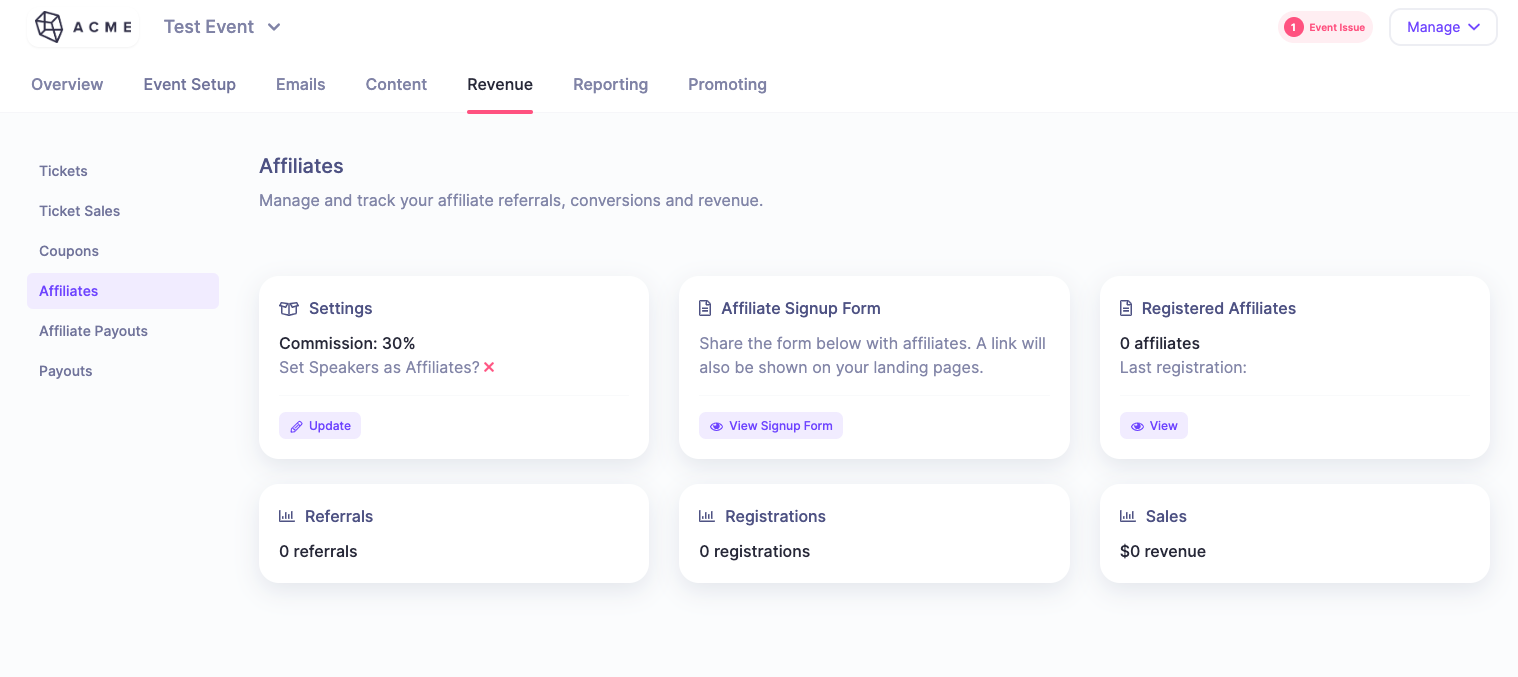
4. Testimonial Marketing
Testimonials are positive words about your business, products, or services from a customer or stakeholder.
Throughout your event marketing campaign, it’s good practice to embed customer testimonials to cement credibility. This is also effective for building trust with potential event attendees and customers. As a result, it leads to higher conversion rates.
Testimonial Marketing Example for Promoting an Event
Embed testimonials on your website and social media pages
Include customer reviews in email blasts and other marketing communications
Use testimonials in your ads
Include testimonials during your event to reinforce your presentation and ideas
Share reviews on social media
It’s easy to set up testimonials in your event marketing campaign with HeySummit as it’s a step-by-step process – see below.
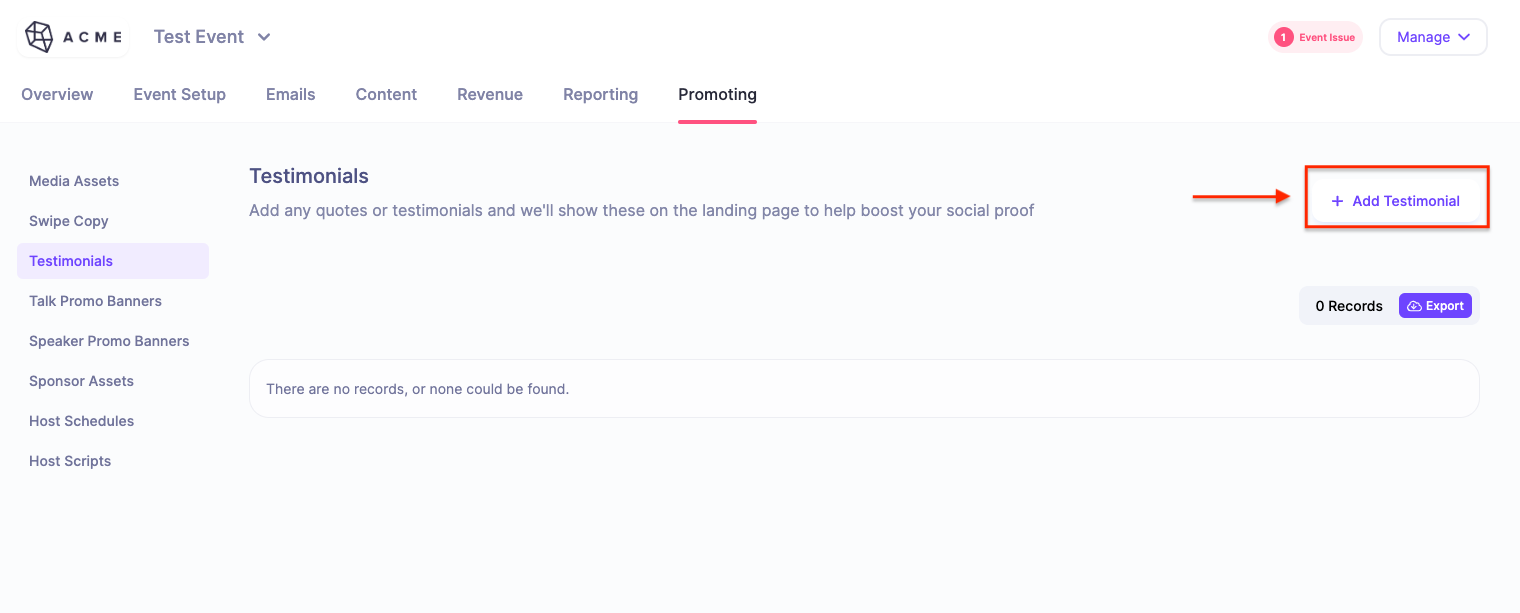
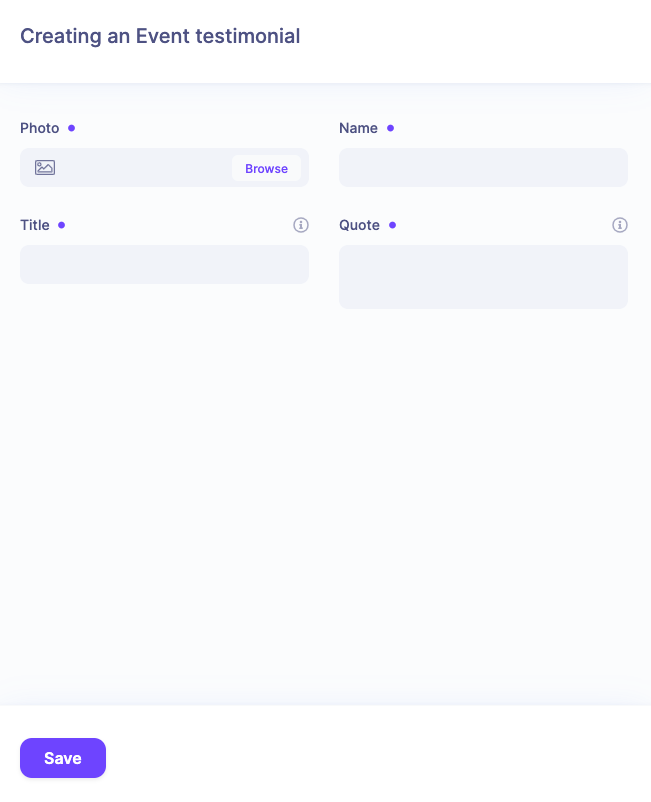
5. Viral Incentives
This means giving event partners or your audience an incentive that motivates them to spread the word about your event. It’s pretty similar to doing special giveaways too as the main purpose is to increase social shares and build awareness.
For instance, incentivize attendees to share a link to your online event and if they manage to get at least 3 event signups, they get a 25% discount in return.
Use viral incentives to boost both event sponsorships and ticket sales. In a sense, it’s similar to affiliate marketing as well because it’s a strategy that leverages your network.
Viral Incentives Example for Promoting an Event
Offer a free entry or 50% discount to attendees that bring a certain number of people to the event
Get attendees to like, share, and comment on one of your social media posts to enter a free giveaway
Viral incentives are easy to implement with HeySummit – see the process below.
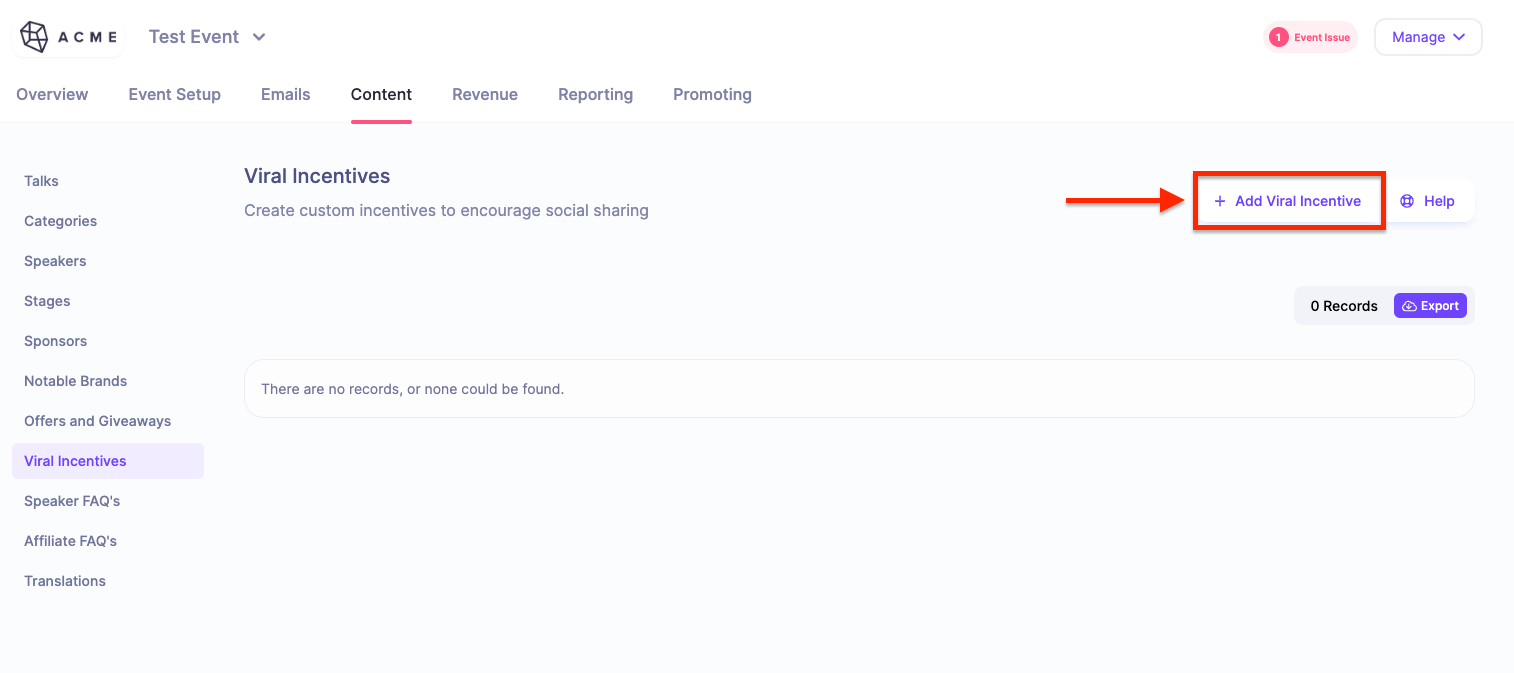
6. Sponsorship Marketing
This is when an external organization (the sponsor) pays the event planner to partake in their event.
Either way, it’s a win-win situation for both the event organizers and the external business. Here’s how:
Sponsors get to raise brand awareness and exposure to potential customers
Event organizers can reach a wider audience due to brand recognition of sponsors
Another benefit for the event hosts is not just the money that they can make from sponsors. But they can encourage sponsorship engagement to improve the event experience and build relationships with them to open up doors for future collaboration.
Sponsorship Marketing Example for Promoting an Event
Let’s say there’s a music festival happening and the organizers want to promote it using sponsorship marketing. The event organizers could approach and offer sponsorship opportunities to companies in the music industry such as:
Record labels
Music streaming services
Instrument companies
In exchange, sponsors get to display their logos on event marketing materials and they get a mention in your press release.
After coming to an agreement, add them as official event sponsors – see the sample process of this below.
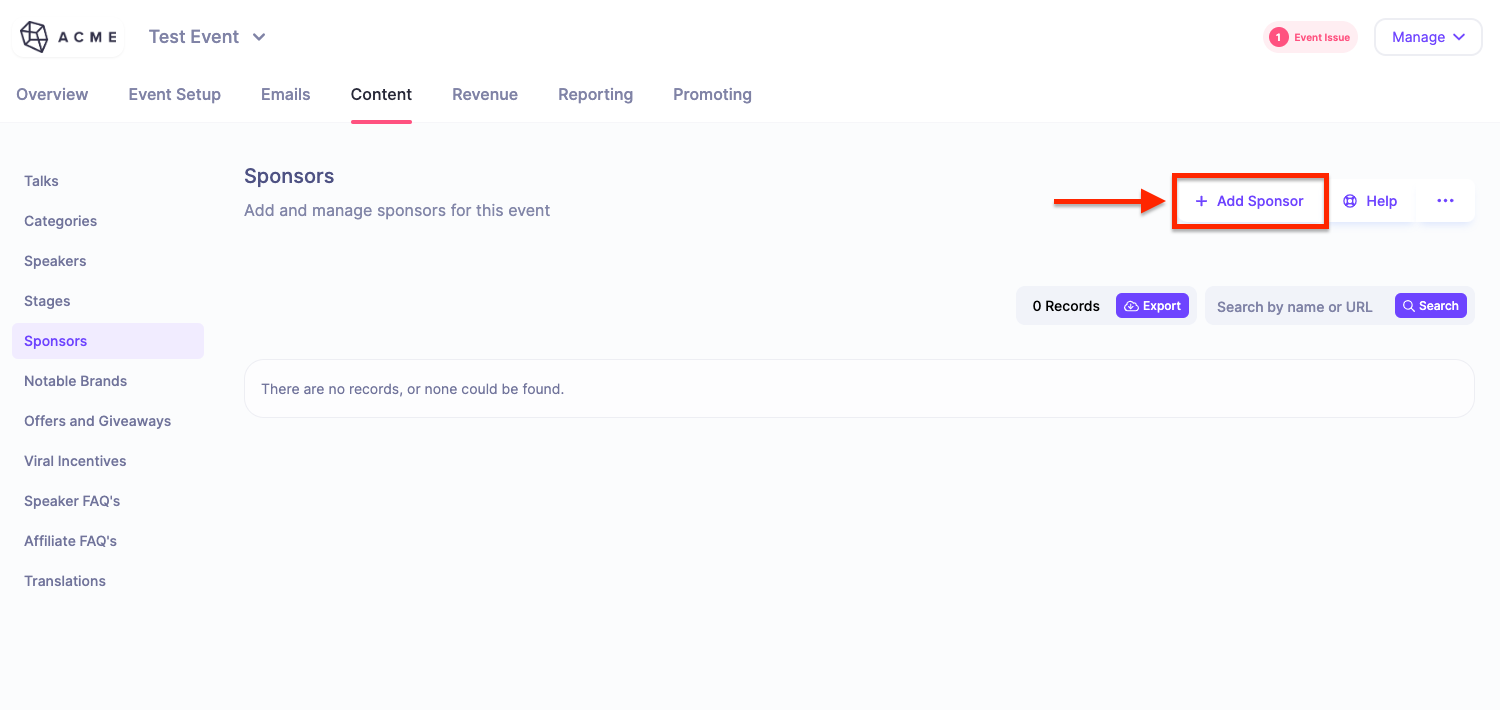
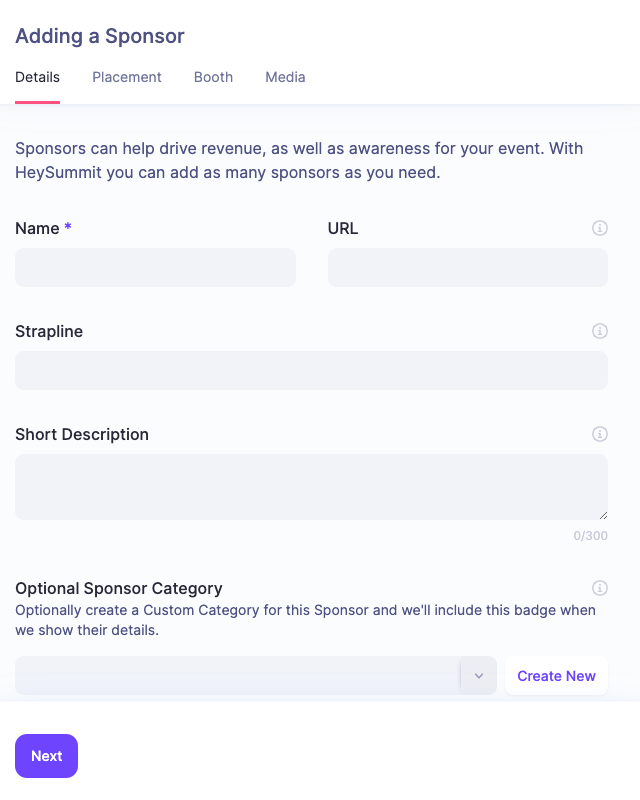
7. Content Repurposing
Content repurposing is the process of taking one piece of content and turning it into another format. An example of this could be extracting highlights from your event and turning them into short videos for TikTok and Instagram. Rather than always coming up with new ideas, repurpose existing content to save time and money. This is essential for your content marketing strategy in general. It’s also valuable for your audience because they get to consume your content in more ways than one.
That said, one of the best ways to know what type of content your audience wants is to ask them directly. Sarah Spencer who turned her blog into a viable side business touched on this in episode 10 of HeySummit’s podcast:
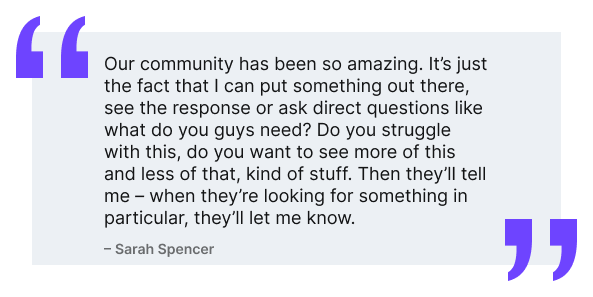
Content Repurposing Example for Promoting an Event
Create social media graphics with catchy headlines using snippets from your keynote speakers’ presentations
After setting up your event’s landing page, convert it into a short-form piece of content for Twitter and LinkedIn
Turn video testimonials into an email newsletter
Convert event highlights into short video formats for TikTok and Instagram reels
8. Social Media Marketing
Your target audience is probably chilling somewhere online on social media – Facebook, Twitter, LinkedIn, Reddit… you name it. But your job is to get in front of them by posting relevant content on those platforms wherever it is they’re hanging out.
Aside from posting content all the time on your business page, another way to use social media is by creating a group.
In terms of online event marketing, you want people to feel like they’re part of the experience and not just spectators. That’s where social media comes into play because you can post more personal content that potential attendees would resonate with.
Social Media Marketing Example for Promoting an Event
Make event announcements and post reminders on ticket availability deadlines on social media platforms
Encourage attendees to post pictures on their social media and prompt them to use a particular hashtag to drive awareness and promote a sense of community
Collaborate with influencers with a significant following in your niche to promote the event and increase engagement
Including calls to action on social media posts and engaging with users in the comments section to increase audience reach and engagement
9. SEO
SEO stands for search engine optimization. This is all about getting your website content to rank higher on search engines like Google.
As opposed to the other strategies listed, this one’s long-term because it can take months before you start to see ROI.
However, it can be a useful strategy for generating leads and ticket sales for evergreen events where replays are available. Over time, it helps you reach more people and bring traffic back to your website.
SEO Example for Promoting an Event
Imagine you’re planning a digital marketing conference in London with replays of the event available. To promote it, you can implement SEO by doing the following:
Identifying relevant keywords. These are the words or phrases that your ideal attendees are searching for on Google. This may include phrases like “digital marketing conferences in London” or “London marketing events”. Use a keyword research tool to see what keywords have a decent search volume.
Optimizing your event’s landing page. After identifying the keywords, optimize your event website content by including the primary keywords in the title tags and headers naturally.
Create valuable website content. Upload content on your site such as blog posts, infographics, and videos. Make it valuable for your audience so that other websites and media outlets will want to link back to you. This brings over referral traffic and improves your chances of ranking higher on search engines as backlinks are a ranking factor.
Keep publishing valuable content. Even after the event has finished, keep posting relevant content that’s helpful to your audience. If replays are available, include calls to action in your SEO content so future readers know that they’re still able to sign up for access to the event replay.
10. Paid Marketing
Paid marketing is where you pay for advertisements on a particular platform such as:
Facebook ads
Google ads
LinkedIn ads
YouTube ads
It’s a great strategy for driving immediate traffic to your event’s landing page. The biggest benefit is that you can target your audience based on factors including demographics, interests, and behavior.
Paid Marketing Example for Promoting an Event
You decide to use paid ads to reach potential attendees. More specifically, Facebook ads and Google ads.
Here’s how the process might look:
Define your target audience. Identify the type of person you’re trying to reach.
Set up your Facebook and Google Ads accounts.
Link your event landing page to your Facebook and Google Ads accounts.
Create ad campaigns with a specific goal. If it’s to drive event registrations, for example, use “Reach” or “Conversion” as the objectives on Facebook ads.
Design your ads. Create eye-catching visuals to catch your user’s attention with a clear event call to action.
Set your budget and bidding strategy. Determine how much you’re willing to spend on your ad campaigns.
Monitor and optimize. See how your ad campaigns perform and adjust targeting, ad creative, or bidding strategies based on the results.
11. Press Releases
In the context of event marketing, press releases are statements or news about an upcoming event. These are either written or recorded for media outlets with the goal of increasing awareness and getting the interest of the public.
Here’s a few advantages of writing press releases:
Get media coverage for your event. A press release can help get your event into the news or other publications, which is great for getting attendees' attention and building buzz.
Build relationships with reporters. Reporters are always looking for stories to cover, so if you can pitch them something interesting, they'll be more likely to write about it and link back to your website or social media profiles.
Build new contacts within the industry. Press releases often include details about how attendees can register for an event or learn more about sponsorship opportunities, so they allow you to connect with potential partners.
Press Release Example for Promoting an Event
Imagine organizing a conference for tech executives in London.
Like all other events, you want to create buzz and get your target audience’s interest by sharing details about the unique value and benefits of being an attendee. So, you decide to write a press release for more media coverage.
After writing your press release, pitch it to journalists and industry publications such as:
Leading tech companies
Popular tech blogs
Developer forums
Local news outlets
12. Videos
Videos are pretty much a necessity nowadays when it comes to hosting both online and in-person events.
Here’s why video should be one of your top priorities for your event marketing strategy:
Build anticipation. Event organizers can use videos to build up the hype with visual storytelling.
Persuade leads who are on the fence. Videos can showcase the event experience better compared to text and images. This helps persuade potential attendees since they’ll have a clearer idea of what to expect.
Social shares. Video content is often shared on social media. So, posting event highlights can be an effective way to drive social shares.
Do livestreaming to get more attendees. For attendees that can’t make it to an in-person event for whatever reason, livestreaming gives them the ability to join remotely. This means you can reach a larger audience and improve ticket revenue potential.
Video Example for Promoting an Event
There are multiple ways to use videos to promote your event such as:
Trailers/teaser videos: create short videos that give people a sneak peek into the type of attendee event experience that they can expect.
Testimonials: post video testimonials on your event’s landing page to address objections and reassure potential attendees.
Recap videos: after the event, post a recap video on your social media accounts showcasing event highlights as well as key takeaways from speakers.
Evergreen content: fuel your content calendar for the coming months or years by reposting videos that capture event highlights.
7 More Event Marketing Factors to Generate More Traffic and Leads
I know, creating an online event already took enough planning…
But to maximize success, it’s worth taking into account these 7 factors to optimize your campaigns so that they drive more traffic and leads. Having these up your sleeve on top of your marketing and viral tools makes for a killer event promotion plan!
On that note, always test different types of events to narrow down and find out what works best for your business.
FOMO
FOMO stands for fear of missing out. It’s about creating the feeling that your target audience is missing out on something fun and valuable. A common example of FOMO is seeing your friends posting about their holiday or party on social media, which can make us feel a bit left out and wishing that we were there too.
When people are feeling FOMO from your event marketing campaigns, they’re more likely to act on that feeling. In other words, this can boost conversion rates and event attendance.
Here’s a few examples of ways to implement FOMO in your strategy:
Post group photos to create a sense of community and belonging
Share clips of the behind the scenes
Post pictures and videos of people having fun at your event
Have a sidebar that shows landing page visitors how many people have already RSVP’d or purchased tickets
Popup Pages
Popup pages are ads that show up on a website. They display information about your event but it’s mainly used to promote tickets and encourage people to take action by registering online.
One reason why popup pages are so useful is that it builds event awareness. No matter how or why people come across your website, a well-designed popup page will get their attention. And if it’s well-written, it’ll draw their interest enough to make them want to learn more.
Website Banners
A website banner is pretty much the same as a popup page as it’s used to display extra information and raise event awareness. The only main difference is where it’s placed – the website banners are usually at the top of the page.
Swipe Copy
Swipe copy refers to pre-written promotional content such as email templates and social media posts. The term “swipe” is the act of copying and pasting the pre-written content into an email or social media post.
Using swipe copy makes it easier to keep your marketing message consistent across different channels and stakeholders. However, they’re also customizable in case collaborators want to make small tweaks.
This is pretty straightforward to set up. See how to create swipe copy below using an event management software like HeySummit.
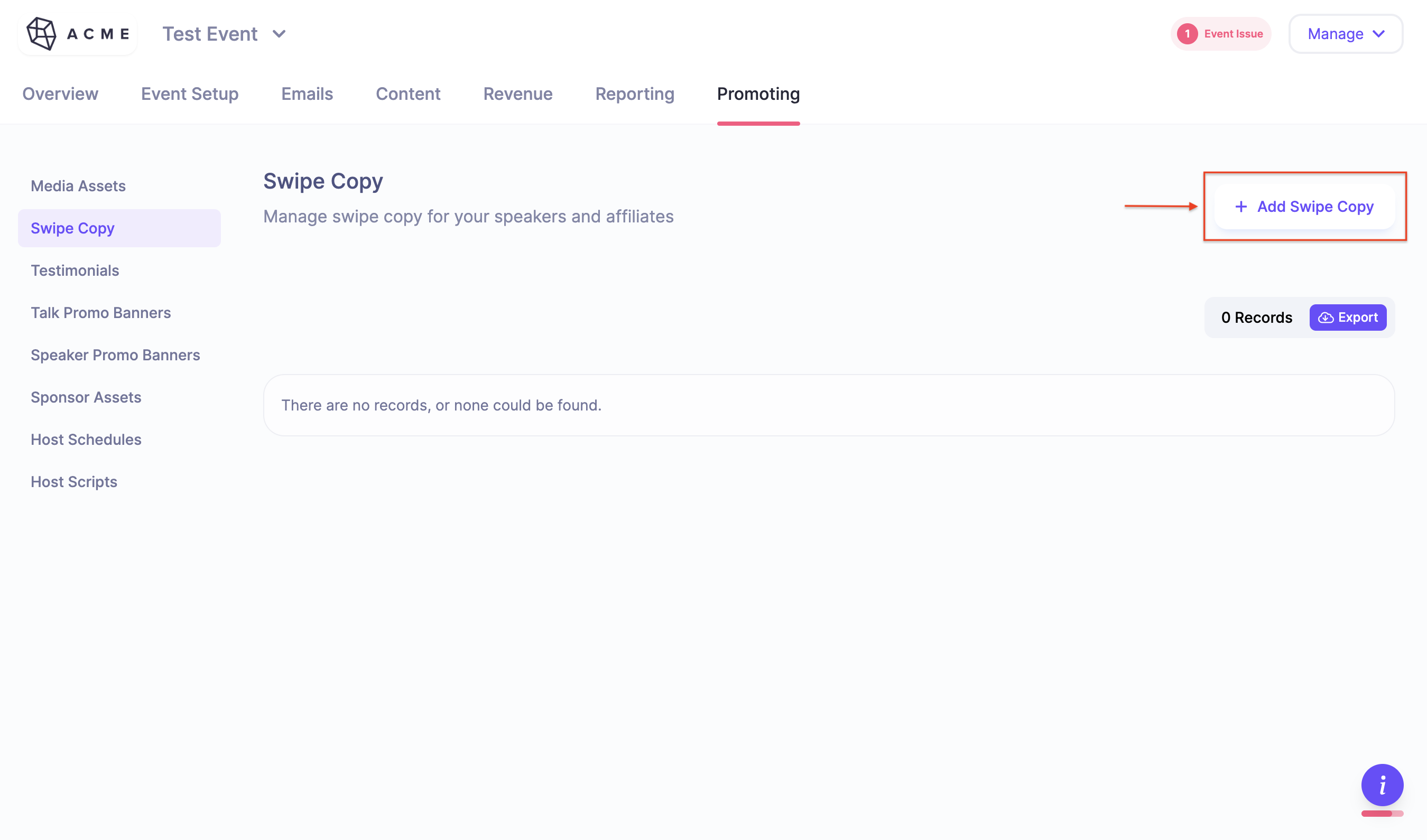
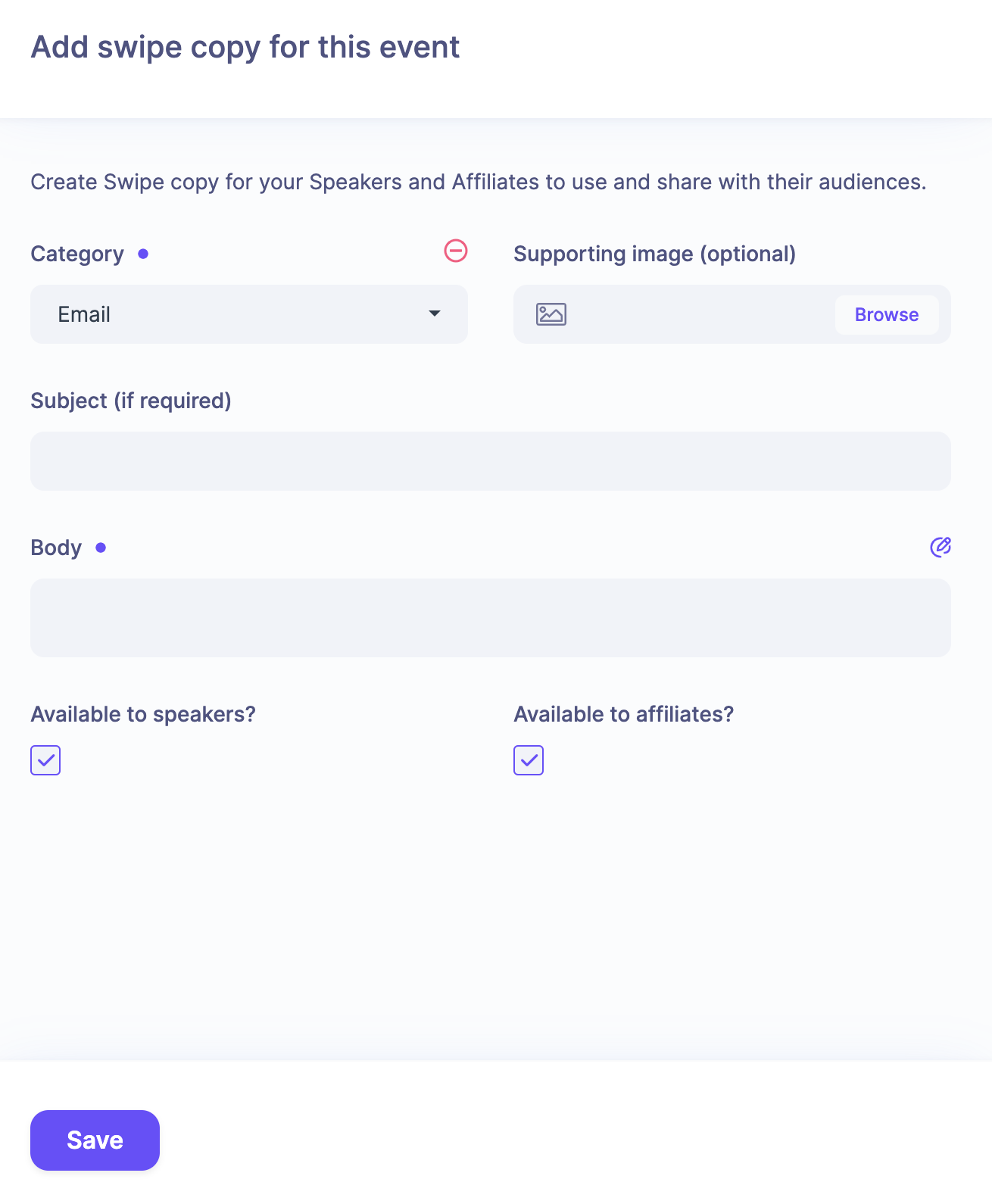
Countdowns
Countdowns create a sense of urgency, which gives users a reason to act now rather than later.
A countdown compels users to take action when it’s relevant and timely. However, build up the excitement first and be sure to give people enough time to plan their schedules.
Here’s a few examples of ways to use a countdown:
Include a timer on the event landing page that shows how long they have left before their limited-time offer expires
Mention the amount of time left to sign up for the event in one of your follow-up emails
Replays
Event replays enable you to make your events evergreen. This means that you can continue generating ticket sales and leads for a longer period of time even after the actual live event has finished.
Moreover, replays give people another chance to join and relive the event experience in case they weren’t able to make it in the first place.
Pre-Registration Pages
Pre-registration pages allow people to reserve their spot for the event ahead of time, which is valuable for event organizers because it gives you the chance to:
Estimate how many people will attend your event
Get more attendees by offering early bird discounts
Make any necessary adjustments
In short, a pre-registration page allows you to collect information from visitors before running your event and maximize sales revenue.
How to Create an Event Marketing Plan That Works
Follow this 7-step process to put together an event marketing plan that brings results.
1. Establish Goals and KPIs
Your goal is how you’ll determine whether or not your event was successful. Here’s a few examples of event goals:
Make profit
Grow pre-launch waitlist of a new upcoming product
Improve customer loyalty
Build partnerships with other businesses in the industry
Now, the KPIs will depend on the goals you’ve set. Here’s a few examples of KPIs to keep an eye on:
Ticket sales
Event attendance rate
Attendee engagement rate
Net promoter score (NPS)
Number of leads generated
Ideally, all the data would be stored in one place using some form of an event analytics dashboard.
2. Draft Event Attendee Personas
An event attendee persona outlines the background information on the ideal type of attendees that you’d like to join your event. This includes details such as:
Demographics
Interests
Motivations
Pain points
Communication preferences
The best event attendee personas require research on your current customers, e.g. surveys. It’s also worth using data analytics tools to get insight into how website visitors react to your landing pages.
Without knowing what your ideal attendees look like, you won’t be able to put on an event that meets their needs and expectations.
3. Have a Budget in Mind
After identifying your target audience, tailor your strategy based on their pain points. Consider what channels they can be found and how you’re going to reach them. For instance, if they’re on Facebook, then a portion of your budget could be poured into Facebook ads if feasible.
An event budget is necessary to manage costs effectively and optimize your strategy for the highest ROI. Not only that, but it’s also important for determining how you’re going to approach future events.
4. Write an Event Value Proposition
An event value proposition is a concise statement about what people can expect to get from attending your event. It summarizes your event’s purpose and highlights why it’s worth showing up.
Take into account the following for drafting an event proposition:
Define the problem your event is going to solve for attendees
Consider the angle that your audience is looking at the problem from
Highlight the benefits and unique value that the event brings to the table
Keep it clear and concise – be straightforward when conveying your message
Here’s an example value proposition of an online event for writers that want to improve their writing skills:
“Level-up your storytelling skills. Learn new techniques. Join one of the most supportive and welcoming communities anywhere online.”
5. Consider How You’re Going to Promote Your Event
Determine the strategies you’re going to implement and which channels you’re going to use. Consider where you’re going to promote your event and the platforms you’ll use such as:
Blogs
Email
Social media
Content is essential for any type of online marketing. However, put more emphasis on the channels that bring the most results and where most of your ideal attendees are hanging out.
It’s also worth considering how you’re going to manage your content. For example, with HeySummit you can monitor different things within your dashboard including:
Email sequences
Viral incentives and giveaways
Sponsor assets
Talk promo banners
And more…
6. Set Event Marketing Timelines
Event marketing timelines are basically schedules that outline the tasks and deadlines involved in promoting an event from start to finish. This is crucial for ensuring that an event is marketed effectively to the target audience.
In other words, this is about determining the right timing. Sending the right message at the right time maximizes attendee signups.
Here’s a step-by-step process for setting an event marketing timeline:
Determine the event date: mark when the event will take place to get an idea of how long you need to promote your event. Then, work backwards from there.
Create a content calendar: have a schedule planned for when certain marketing activities must be implemented.
Build the hype: focus on executing pre-event marketing activities to increase registrations and ticket sales.
Ride the wave: have a strategy for promoting your event as it’s happening. An example of this could be using a particular hashtag on social media when posting about the event or livestreaming the event on YouTube.
Keep the hype going: the marketing doesn’t stop once the event ends. In fact, after the event has finished, it’s crucial to keep the hype going for as long as possible to generate more leads and sales.
7. Analyzing the Metrics
Use the following event marketing formula:
Event Success = What you get out of it ÷ What you put into it
Refer back to the business goals and KPIs you set at the beginning. See where you excelled and where you fell short – what went well and how could’ve things gone better?
Analyze how your event performed. Use the metrics shown to make data-driven decisions; this is crucial for developing your future event strategies.
B2B Event Marketing vs B2C Event Marketing
In a nutshell, here are the main differences between B2C and B2B when it comes to event marketing.
Target audience: B2B events are targeted at businesses and professionals whereas B2C events are targeted at individual consumers.
Content: B2B events are focused on building thought-leadership status by providing value to businesses. B2C events, on the other hand, often aim to spark an emotional connection through entertainment and social experiences.
Marketing message: B2B events highlight products or services that are relevant to businesses and professionals. Conversely, B2C events highlight products or services that appeal to individual consumers.
Sales process: B2B events involve a longer sales process as there are multiple decision-makers involved. However, B2C events often involve impulse purchases and may be more focused on driving immediate conversions.
Goals: The ultimate goal of B2B events is to generate leads by building relationships and establishing credibility in the industry. In contrast, B2C events aim to generate buzz, traffic, and sales.
Event Marketing for Solopreneurs vs Event Marketing for Companies
The biggest difference between hosting events as a solopreneur and as a company is that the companies will have a larger budget to allocate. Here’s what solopreneurs double down on when it comes to event marketing:
Social media
Email marketing
Affiliates and referrals
Coupons
Collaboration with other local and small businesses in the industry
Holding more intimate events like workshops and webinars
Personalized marketing approach, e.g. directly reaching out and inviting prospects to events or tailoring event content to their specific needs
Word-of-mouth
On the other hand, companies have more resources at their disposal – here’s a few examples of what they can put more focus on when it comes to event marketing:
Hiring dedicated staff for the event to manage the planning process as well as logistics and promotion
Investing in event technology like mobile apps to enrich the attendee experience
Forming partnerships with other corporations and media outlets
Reinforcing event awareness and messaging as they likely already have strong brand recognition
PR tactics such as press releases to generate media coverage
Hosting large-scale events where thousands of attendees are expected
Key Takeaways + One More Piece of Advice
Aside from creating an event, another hurdle is setting up your event marketing strategies.
However, everything is easy to manage with HeySummit because they’ve simplified the entire process to a step-by-step framework. Moreover, you can set up your event marketing strategies within the platform so that everything is in one place.
All that being said, each of the strategies and steps in this guide will help you plan a successful event that leads to business growth. Executing well-planned events is a viable way to grow your business as it has the potential to supply you with targeted traffic and continuous leads over a long-term period.
A final piece of advice from us is this:
Prioritize an event marketing strategy that gives tremendous value over building your attendee list.
The best type of marketing is one that feels natural. In fact, it doesn’t feel like marketing at all because of how much value people are getting from your campaigns. If you can consistently have this effect on your audience and communicate your value proposition concisely through different channels, watch the results!
Table of Contents
What Is Event Marketing? The Main Types of Event Marketing That Generates Leads12 Event Marketing Strategies for Content Creators and Companies of all Sizes7 More Event Marketing Factors to Generate More Traffic and LeadsHow to Create an Event Marketing Plan That WorksB2B Event Marketing vs B2C Event Marketing Event Marketing for Solopreneurs vs Event Marketing for CompaniesKey Takeaways + One More Piece of AdviceTry HeySummit free
Your All-in-One Event Platform. Easily grow and engage your community online and offline, irrespective of scale.
Share this article on:
